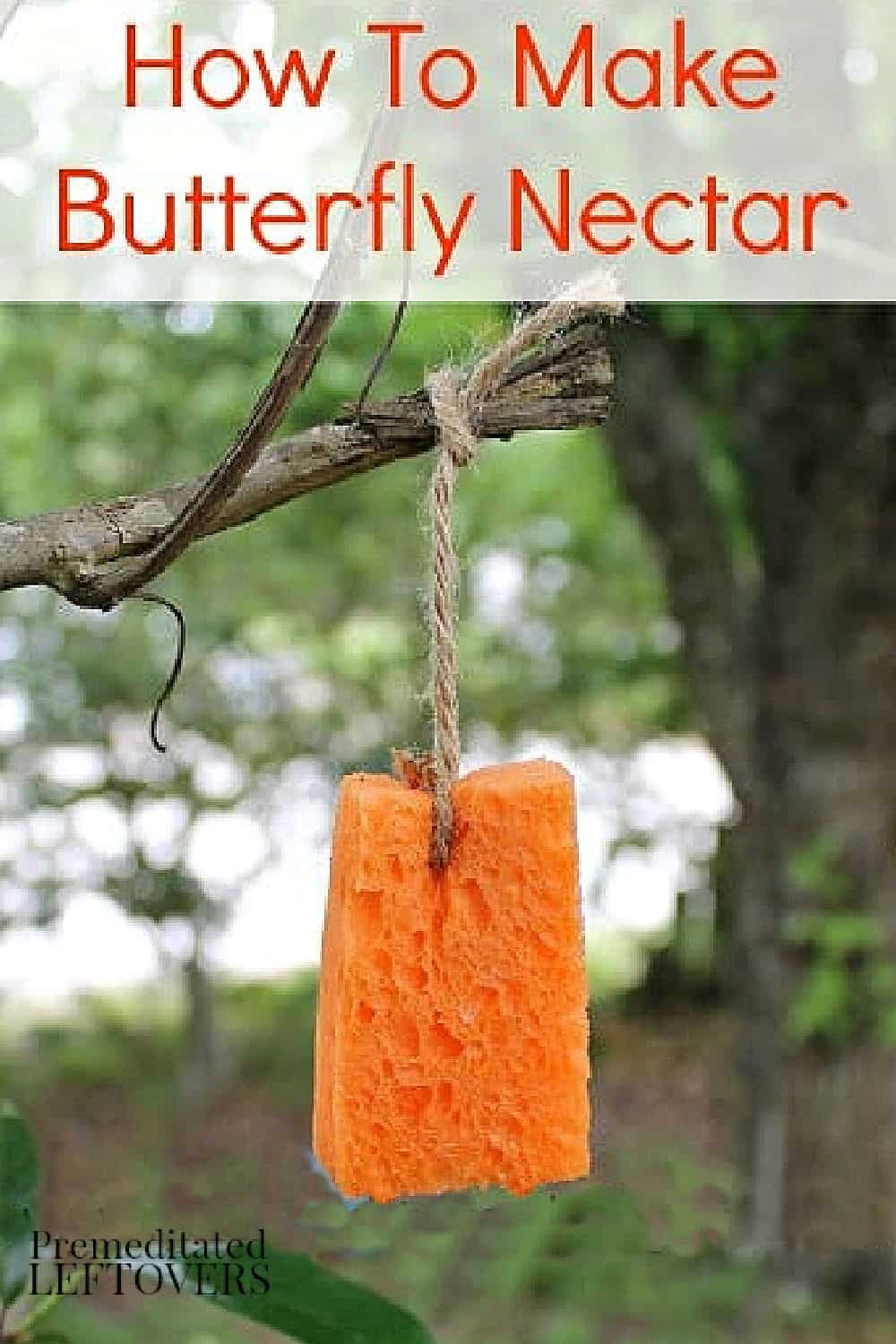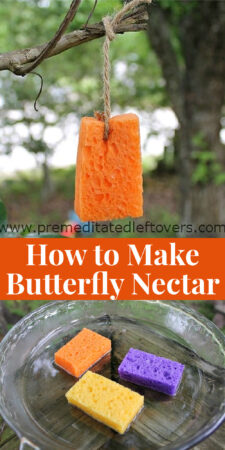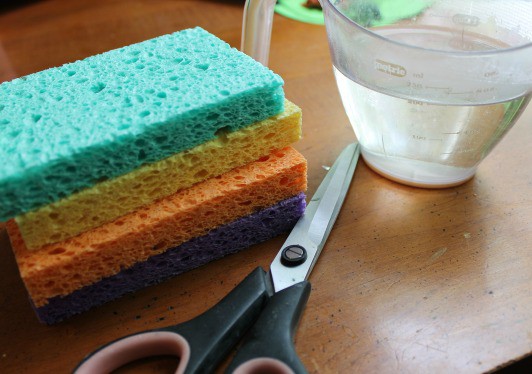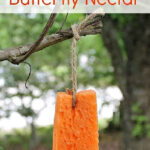Use this recipe for how to make butterfly nectar to make butterfly food to place in your yard.

Besides the myriad of beautifully colored and wonderfully scented flowers that you can plant throughout your garden and yard, there are a few other things you can do to draw butterflies in and keep them coming back. Making them feel welcome with food and shelter works for relatives and butterflies alike. One thing is to offer them butterfly nectar scattered about, hanging in trees, or placed in shallow dishes tucked in shady spots. It costs very little to make butterfly food and takes just a few minutes. Children love helping to put together this simple recipe for butterfly nectar and watching the parade of winged wonders that will surely pass by your yard.
How to Make Butterfly Nectar Recipe
Supplies:
- Sponges
- 1 cup water
- 1/4 cup granulated sugar
- twine or string
Directions:
- In a small saucepan bring 1 cup of water to a boil, stir in sugar and simmer until dissolved.
- Remove from heat and cool completely.
- While the syrup is cooling cut sponges into 4 smaller rectangles.
- Cut or poke a small hole in each sponge.
- Cut 8″ length of string and thread through a sponge.
- Dip the sponge in syrup until full, allow excess to drip from the sponge before hanging on limbs, porch railings, or anywhere else you want to leave a “drink station” for your winged friends.
Alternatively, you can place several sponges in a shallow dish with the syrup mixture and place the butterfly food in your garden.
Be sure that you also have plants in your yard for the butterflies as well as the plants that the caterpillars will need to feed on after hatching. Research the butterflies that are common to your area, and what plants they need for their full lifecycle, then add those plants to your yard. You don’t want to use this butterfly nectar to attract butterflies to your yard if you cannot support them.
Printable Butterfly Nectar Recipe
Homemade Butterfly Nectar Recipe
Materials
- Sponges
- 1 cup water
- 1/4 cup granulated sugar
- twine or string
Instructions
- In a small saucepan bring 1 cup of water to a boil, stir in sugar and simmer until dissolved.
- Remove from heat and cool completely.
- While the syrup is cooling cut sponges into 4 smaller rectangles.
- Cut or poke a small hole in each sponge.
- Cut 8" length of string and thread through a sponge.
- Dip the sponge in syrup until full, allow excess to drip from the sponge before hanging on limbs, porch railings, or anywhere else you want to leave a "drink station" for your winged friends.
More Ways to Attract Butterflies:
How to Make a Butterfly Puddler
6 Frugal Ways to Attract Butterflies to Your Yard
Attracting Butterflies with Butterfly Bushes
Originally published April 27, 2014. Updated on April 26, 2021.






Jennifer says
My son has rescued a malformed winged monarch butterfly. Not sure what to do with it, so we made up nectar, soaked a sponge in it and created a habitat for it to live out the rest of its days. We’re giving it fruit and have placed a flowering plant stem in the tank. I feel bad keeping it in a tank but I think it would die quickly in nature given it’s malformed wing. My son is a kind hearted soul and has rescued many animals and insects. Thanks for your informative post for providing food to wildlife. Sometimes they really need the help!
Cheryl says
From experience I can tell you this…..it it a heck of a lot harder to raise butterflies than it seems. Chemicals, and even natural insectices, are deadly to butterflies. They are such fragile babies. I would say that a water-only puddler is a wonderful idea for most of us. I get butterflies by watering my garden overhead (not tomato plants – they don’t like their leaves wet). I don’t put out sucrose or fructose food because it will attract every other insect in the area, also. Butterflies don’t like contaminated food or fluid sources anymore than we do. You have to decide if you want to do battle with unwanted insects everyday. I do grow milkweed, but the constant infestation of aphids and ants is horrific and wearisome. Butterflies won’t lay eggs on infested plants. Read, read, read, especially before educating youngsters. There is so much ‘knowledge’ that I have had to unlearn. And finally, don’t use artifical sweeteners. The butterflies will be fooled alright…..and they will die. Plant an attractive landscape that you like and are willing to care for daily, and you will see butterflies, just maybe not hoards of them. That’s OK; Leave some for my yard ; ) Bless all of your efforts.
lisa says
This looks like a nice idea but I would add that I would SERIOUSLY clean a new sponge before using for this–there is always weird soapy stuff that comes out of fresh sponges. Repeatedly soak a new sponge in fresh water and squeeze it out many times before using it for this project.
Max says
It’s a Nice idea Jody but is it good for butterflies to eat industrial processed sugar?
Instead of natural sugar from flowers???
I Think it’s better to plant plants good for honey, it attracts them a lot and doesn’t do any harm to their health and DNA.
In the peace of Christ,
Max
Zoey says
Plant butterfly weed and milk weed . These are natural butterfly food. These are indegenous to the area. Butterfly bushes are imported. The butterfly’s will thank you
Nancee says
Your responses to people: “plant butterfly weed and milk weed” show that you are not very knowledgeable about the subject of what plants to use to draw butterflies to one’s garden.
“Butterfly weed is milkweed (one word)” Yes, there is a butterfly bush that the butterflies and hummers love, but it’s just one of many.
The host plant, the plant that the female Monarch lays eggs on, is the only plant that the Monarch caterpillar can eat. For 14 days, the Monarch caterpillar eats, growing up to 2500 its size as a hatchling. It then forms a Chrysalis (jade with gold dots) and in about 10 days, the Monarch butterfly emerges. Hopefully. If left in the garden, the Monarch has a low survival rate. Predators, parasites, and pathogens limit how many Monarchs will survive from egg to butterfly…only 1-2% will survive.
And then we have the well-meaning, but unfamiliar person extending advice that is completely wrong.
Max, you are right. It is not suggested that sugar water should be available to Monarch butterflies. The cut fruit idea is used, but you have to be consistent in removing the fruit pieces every day, and washing and sterilizing any sponge or container with any fruit juice they may rest in. Pathogens will grow quickly and actually kill the butterflies.
Please, Zoey, educate yourself on this subject or suggest a site that will have the correct answers. You are actually setting up death traps for butterflies.
Lynn says
Why do you have to be so mean and patronizing ? We get it , you are very knowledgeable – this is the same mixture that we feed hummingbirds!
Tom says
Nancee besides being an ass, you are also wrong or at least incomplete in your descriltion. I have monarch chrysallis, 3 of them currently that are green not jade and they are dill before settling into my parsley to transform.
Cindy says
Nancee you are so rude. You don’t need to put someone down to get your point across.
Brenda says
You are all being Sensitive Sally’s. It was good info.
Hilary says
Bees are a necessity for plants and the earth, hopefully it does help bees, too.
tracy grisdale says
some wonderful ideas for the classroom
G says
Just like with hummingbird feeders, this will attract ants. You may not want it too close to your home.
Kathy says
Doesn’t this butterfly nectar attract bees too?
Marie says
I would love to try this, but was wondering the same thing, seems like they would dry out fast in the heat.
kim says
How often are the sponges changed and are they sanitized and reused?
Nicole Elliott says
This looks like so much fun! We have lots of “nasty” sweet loving critters here in Texas–have you had any problems with wasps, hornets, or bees being attracted to these?
Jody says
Sometimes Nicole, they do attract other unwanted pests. you get some thorns with the roses :(. So far I have not seen any this season, but just lots of butterflies and the random beetle we have to rescue out of there.
Michelle says
How often would you need to rewet these with the solution? Is this something you would need to do daily or would it be good for a few days? Thanks!
Maria Gonzalez says
We have problems with snails, help
Donna says
Put beer in dishes. They drink the beer and die.
Desi Powell says
Hello, I am 13 years old turning 14 in November. I love to garden, i love the outdoors, i also love animals with all my heart (God first of course),go fishing with my ‘special’ friend, and want to be a hunter. I would like to know how to keep chickens. My family has 10 acres of land, 2 dogs, 2 cats, and 2 rats. (All of which are mine). And my mom and I are thinking of getting chickens. And quiet a few of them. (About 10-15) I just wanted to know if you prefer any specific chicken coop, able to hold a good amount of chickens or 2 good sized coops. (Or at least a chicken coop plan, which is a whole lot cheaper).
Thank You for your time,
Desiree
Linda says
Desiree: About Chickens. There are so many coops but I wanted to say plant peppermint around the coup. Most mice and rodents don’t like peppermint so it helps keep them out of the coup. Nothing is one hundred percent guarantee. But also place chickens in the chicken nest to help keep the mice out. If you put chicken coup in the pinterest search or just chickens you will get a lot of ideas about raising chickens.
Jan Jones says
Desiree
I hope you get the chicken they are so much fun and a lot of work. My grandson & I (along with his Dad’s help ) raised 12 baby chick’s (which we bought at the local farmers store) we used metal water tank with a drop light for about the first 6 weeks in side the barn and covered the top with boards on each side with a piece of wire across th middle. Put shaving in the bottom to clean out daily then we moved them to a well fenced area of chicken wire coup lots of different styles. Kept the critters out Good luck ours laid eggs after about 4 to 5 mths. We had alot of FUN
Gmielk says
I would suggest the basics. Gated yard, roofed and walled safe house. bedding, lg. waterer, and food dispenser. Then there’s the lice, mites and other meds they need until 6 months, then it’s you preference to be organic or not. Once they are older you can choose to let them into your grass yard to forage for insects and such cause that’s what chickens do. Hope this helps:)